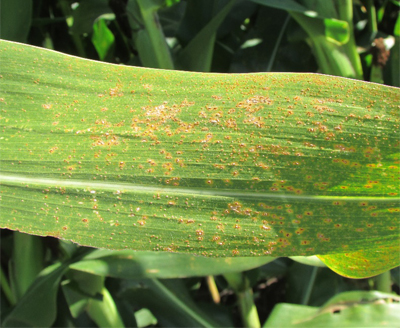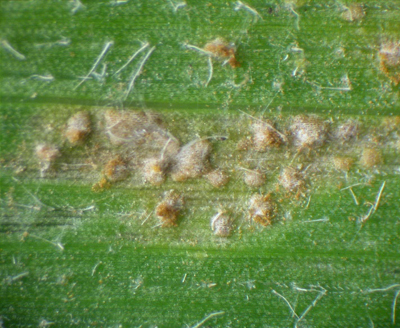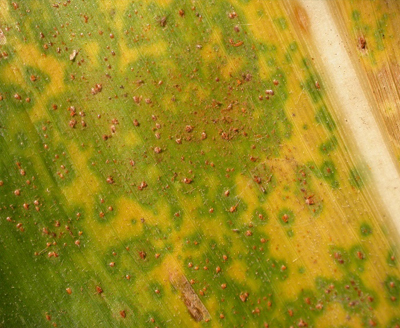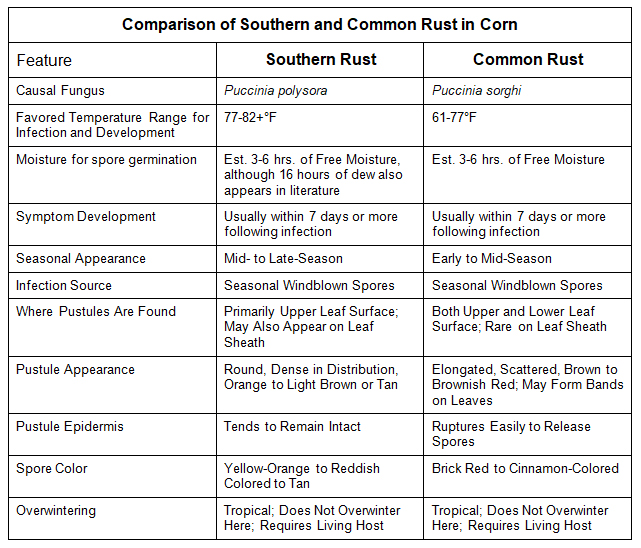
- Southern rust has been observed on Midwestern corn, including corn in southern Illinois.
- This disease does not overwinter here. New infections arrive each year via windblown spores.
- Southern rust is favored by warm temperatures and usually shows up here in August and early September.
- It is seldom profitable to treat corn for southern rust, except when the disease arrives early or when it infects susceptible seedcorn inbreds, sweet corn, and popcorn.
Introduction:
Southern rust is a foliar, fungal disease of corn. It is primarily a tropical disease that periodically arrives in the Midwest late in the season. Like many of the rust diseases, southern rust has a complex life cycle. However, in the Midwest, southern rust is caused by repeating infections from spores that are windblown into the area. In Midwestern field corn, southern rust rarely causes serious yield losses, although this disease likely increases susceptibility to later stalk rot problems.
Disease Profile:
The table included with this article summarizes many of the features of southern rust and compares these features with those of common rust (Puccinia sorghi).
Southern rust is caused by the fungal pathogen, Puccinia polysora. Neither common rust, nor southern rust overwinter in our area. They both require living hosts. These diseases are tropical in origin and annual, local infections occur from windblown spores arriving from the South. There are multiple races of southern rust. This is of little consequence for the Midwest, but a longstanding source of resistance to southern rust in the South was found to have been overcome by a new race of the disease in 2008.
Southern rust is favored at temperatures between 77°F and 82°F, or higher. The disease usually doesn’t become established in the Midwest until August or September. Recently, southern rust has been detected in southern Illinois, western Missouri, and eastern Nebraska, so infections may be off to an earlier start this year.
Southern rust requires free moisture, like dew, on the leaf surface for between 3 and 6 hours. Some literature indicates that free moisture is required for a longer time period, up to 16 hours. The pattern of disease appearance often reflects where moisture was present on the plant tissue. Young leaf tissue is most readily infected by corn rust diseases. Late-planted corn often experiences more severe damage from southern rust.
Rust diseases are polycyclic, meaning that they repeatedly infect, as long as susceptible plant tissue is available. The two corn rust diseases have complex biology with five different spore types. It is one of these spore types, the urediniospores, that blow into our area to cause rust infections and repeatedly infect corn. Southern rust is capable of rapid increase in systemic infection once it becomes established.

Symptoms:
Southern rust typically infects plant tissue at the ear level and above, the youngest part of the plant. Initial infection results in appearance of tiny yellow spots in tissue as soon as 7 days following infection. These yellow spots rapidly progress to formation of pustules. Southern rust pustules develop mostly on the upper leaf surface, on husks, and on leaf sheaths. Pustules take the appearance of tiny, round, raised spots in dense clusters. (Fig. 1) Pustules rarely form on the underside of leaves, although they may develop along the midrib of leaves on the leaf underside. When pustules form in leaves, there is frequently a yellow spot on the opposite side of the leaf.
Yellow haloes may appear around pustules with southern rust, depending on the level of tolerance or resistance in the corn hybrid. Most corn hybrids grown in the Midwest have some level of resistance or tolerance. A number of sweet corn and popcorn lines are susceptible to southern rust, as are several seedcorn inbred lines.
A peculiar effect has been noted with the rust diseases of corn. These diseases are parasitic in nature. Occasionally, large areas of leaves will become yellow from rust infection, but each pustule continues to have green tissue surrounding it. The pathogen appears to support leaf function in the area around the pustule so that the disease can continue to withdraw nourishment. (Fig. 3)
Southern rust pustules are orange to tan or light brown in color. The epidermis covering the pustules remains intact much longer than with common rust, before rupturing to release the yellow-orange to tan-colored spores. (Fig. 2) Southern rust is a prolific spore producer. Walking through a field infected with southern rust results in discoloration of skin and clothing with the orange-colored spores.
Late in the season, a different kind of spore may be produced with southern rust infections. Teliospores are very dark-colored spores produced in pustules that form in a horseshoe shape or ring around the original lesion. These spores are of no importance in our area, but they may complicate disease diagnosis.
Damage and Yield Loss:
In the Midwest, yield losses from southern rust in field corn are generally low, although the disease appears to predispose corn to later stalk rots. In the South, southern rust can cause yield losses greater than 25 percent in susceptible hybrids.
The greatest threat from southern rust in the Midwest is to seedcorn inbreds, as well as to susceptible sweet corn and popcorn lines. Significant yield losses may occur to these crops. Southern rust may occur on the same plants with common rust or other diseases.
Southern rust consumes sugars need by the corn plant and also damages the leaf surface, resulting in desiccation of tissue. Susceptible corn hybrids and specialty corn lines may be rapidly affected by southern rust. This disease re-infects susceptible tissue as long as conditions are favorable, with extremely rapid damage progression occurring. Prolific spore production also results in infections in additional fields, downwind.
Managing Southern Rust in Corn:

There are no practical treatment thresholds for southern rust. The fungicide treatment decision requires knowledge of the susceptibility of the corn being grown. When southern rust arrives earlier than usual, or when corn is late planted, susceptible corn should be treated at the first appearance of the disease. Southern rust infection and damage can progress very quickly if untreated.
Seedcorn inbreds, sweet corn, and popcorn may require fungicide treatment to prevent significant damage from southern rust. Fungicide may need to be applied every 7 to 14 or 21 days. This depends on susceptibility of the corn line, disease onset, fungicide choice, and conditions for reinfection.
Field corn hybrids in the Midwest rarely will need fungicide treatment for control of southern rust unless a known susceptible hybrid is being grown. The usual late arrival of southern rust makes fungicide application impractical and of low economic benefit.

Fig. 1 – Distribution of Southern Rust Pustules on Corn Leaf
Fig. 2 – Typical Appearance of Southern Rust Pustules
Fig. 3 – Green Tissue Preserved Around Southern Rust Pustules